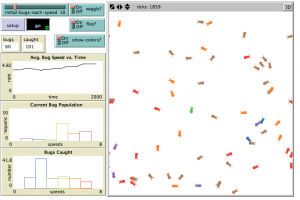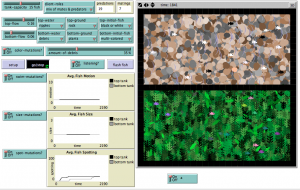“Nothing in biology makes sense except in the light of evolution” is the title of an of-quoted essay by noted evolutionary biologist Theodosius Dobzhansky. It underscores the explanatory power of evolution, transforming biology from a descriptive science to one that can provide generative mechanisms that account for what we observe. Yet despite its importance, it is widely misunderstood and rejected by the population at large, and it has been shown to be challenging for students. Educators and psychologists have described a host of student misconceptions about evolution, including difficulties with essentialism of species, confusion about natural selection mechanisms, as well as issues with the relation between micro- and macro- evolution, the status of evolution as a theory, intentionality and teleology in evolutionary trajectories and explanations, and the passage of “deep time”. Clearly this is an area where there is great need for improved instruction and materials.
To address this issue, we have designed a state-of-the-art curriculum that closely aligns with the Next Generation Science Standards. This unit consists of a suite of activities designed to facilitate inquiry into core evolutionary mechanisms such as natural selection, genetic drift and speciation using computational models. Each of the activities is designed around a computational model that simulates the evolutionary phenomena of interest. These models serve as environments for designing and conducting experiments to collect and analyze data to construct scientific explanations for the evolutionary phenomena of interest. Each activity begins with a pre-class discussion to introduce students to the central question of the activity and to elicit students’ prior ideas about the topic. After students have interacted with the model, either alone or in small groups, the teacher facilitates a consensus-building discussion in class to synthesize what students learned about the mechanisms and outcomes of the evolutionary phenomena.
These activities have been pilot-tested in high-school biology classrooms, and revised based on the implementations.
Overview of Activities
1. Selective Breeding: How can selective breeding change a population?
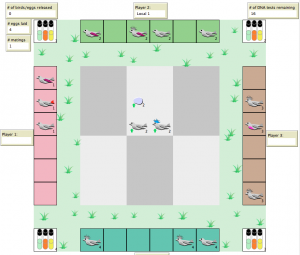 Selective Breeding HubNet Model Client View
Selective Breeding HubNet Model Client View
Purpose
The purpose of this activity is to 1) familiarize students with selective breeding as a mechanism that can change populations, 2) introduce the distinction between random vs. non-random selection events (genetic information passed to offspring vs. intentional selection by breeders), 3) introduce the distinction between selection of individuals to breed vs. selection of individuals to remove from a population, and 4) show that selections events can progressively lead to rare recombinations of trait variations in offspring that meet a desired outcome in a population, when such a selection is repeated over multiple generations.
Description
This activity begins with a brief whole-class discussion designed to elicit students’ prior knowledge about selective breeding, particularly in cats and dogs.
The class then breaks up into teams of four to engage in a participatory simulation to breed a group of fancy-looking birds. Each student in a team plays the role of a bird breeder who begins the simulation with a random collection of birds. Bird breeders within a team cooperate with each other by exchanging birds for breeding to selectively breed for four homozygous recessive traits. As the simulation progresses, each team has to strategize about which birds to breed or release into the wild. Each team also has access to a DNA Sequencer that allows them to sequence the DNA of a limited number of birds to determine their genotypes. The teams in the class compete against each other to be the first to attain the goal. Students collect data in the form of plots representing how the allele and phenotype frequencies in the population changed as a result of selective breeding. This data is analyzed to identify the mechanisms of selective breeding as enacted by the students in the participatory simulation including selection of which individuals will reproduce and which individuals will be removed from a population and random allele selection (via. meiosis) for passing on genetic information to offspring. Students also identify the outcomes of the selective breeding process (limited genetic diversity).
2. Natural Selection: How does nature select for some trait variations over others?
Purpose:
This activity has been designed to foreground how natural selection emerges from the interaction of dual mechanisms: a) variation in heritable traits in a population, and b) selection pressures in the environment acting on individuals to give some variations a competitive advantage over others. These dual mechanisms enables students to develop a deep understanding of natural selection as an increase in the proportion of individuals with advantageous heritable trait variations in a population over multiple generations. The activity also stimulates a discussion on how these mechanisms compare to those of intentional selection and random selection in selective breeding.
The Activity
In this activity, students use a computer model to assume the role of a predator in a population of prey (bugs). They hunt bugs using two different predation strategies, each of which generates a different selection pressure and a different outcome from natural selection. They compare how the competitive advantage for different variations of speed in the prey changes based on the different selection pressures. At the end of class, the teacher develops a class consensus on the big ideas for: the two conditions necessary for natural selection and how these two conditions lead to competitive advantage, preferential selection, and the change in distribution of trait variations in the population.
3. Genetic Drift: How do random selection events alone change gene pools?
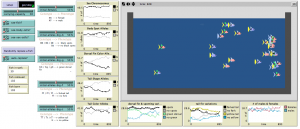 Fish Tank Genetic Drift NetLogo Model
Fish Tank Genetic Drift NetLogo Model
Purpose
The purpose of this activity is to describe how random fluctuations in gene frequency in a population are the result of the random sorting and recombination of genes in sexual reproduction (through meiosis and fertilization) as well as to explain why this drift in gene frequency can result in the loss of alleles from a gene pool.
Description
Students design and run experiments using a computer-based model of a fish tank by varying conditions for fish reproduction. They collect data to track changes in allele frequency due to results of meiosis and fertilization events. At the end of class, the teacher develops a class consensus for how genetic drift emerges from fundamentally random processes and can result in the persistence or elimination of traits in a population over time.
4. Adaptation and Survival: What outcomes will result from both mutations and natural selection?
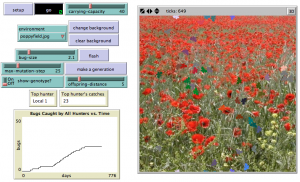 Bug Hunt Camouflage NetLogo Model
Bug Hunt Camouflage NetLogo Model
Purpose
The purpose of this activity is to discover how the combination of mutations, natural selection, and environmental change lead to a species adapting to its environment.
Description
Students compete as a team in a bug hunting competition to eventually generate a simulated form of natural selection with an outcome of adaptation by camouflage. They see how mutation is modeled in the simulation, and investigate the outcome resulting from a change in environmental conditions in two independent computer explorations. Students compare their outcomes with a partner, and develop explanations for why the outcomes are similar (progressively better adapted populations), and how they are different (variation and fluctuation in specific traits in the population). They also identify how mutation and environmental changes contribute to both of these outcomes.
5. Adaptation and Sexual Selection: How do mates influence adaptations?
Purpose:
Engaging in this activity enables students to reason about potential tradeoffs between adaptation for survival and adaptation for reproduction, and to recognize that populations adapt to balance the pressures from both forms of selection, which vary depending on the environment.
Description
Students compete as a team in a water body of fish to generate two simulated forms of selection, natural selection and sexual selection. The resulting outcomes vary based on environmental conditions: fish become progressively better camouflaged over time in environments dominated by predators while they become progressively more garish over time in environments with mates. Students investigate the tradeoffs in adaptation when multiple selection forces are at play and recognize that tradeoffs can apply to trait variations that are too extreme. They compare their outcomes with a partner to develop rich explanations for how mutation and environmental conditions changes contribute to resulting outcomes in the model.
6. Speciation: Where do new species come from?
 Plant Speciation NetLogo Model
Plant Speciation NetLogo Model
Purpose:
This activity has been developed to help students understand how different evolutionary mechanisms contribute to speciation. In particular, students will reasons about how genetic drift, variation in environmental conditions, sexual selection, and tradeoffs in competitive advantage for different trait variations can lead to the emergence of a new species.
Description
Students revisit the definition of a species and discuss whether genetic drift alone could account for why new species emerge. They then use a computer model of plants in an ecosystem to explore how speciation always emerges from a single population over time under certain conditions. They then reason about an alternate set of mechanisms that would lead to speciation more rapidly and more frequently: where genetic drift initiates the pathway to speciation. But sexual selection and coevolution are the driving mechanisms that continue to reinforce the emergence of this outcome. They study examples of how speciation has been created in laboratory conditions with human intervention and contrast the mechanisms at work in real world ecosystems when new species emerge.
Using the Unit in Your Classroom
The activities in this unit have been pilot-tested in several high school biology classes in the last few years. Based on our own research and observations, and feedback from teachers and students, we have revised existing activities, introduced new ones, and replaced activities that were not particularly productive for students. These implementations have provided us with insights to develop a better understanding of how we can leverage these computational models to design activities that are intellectually accessible, insightful and engaging for students.
First, we have noticed that these models and the explorations we have designed help students develop a deep understanding of the content. The visualization in the model coupled with the dynamically updating plots provide students with real moment-by-moment feedback on how a certain evolutionary mechanism plays out in the model. This dynamic feedback in turn provides insight into the content. Moreover, using these models as testing beds to run experiments and test their own theories in class, either independently or in small groups, enables students to refine their own understanding of the content. It is not uncommon for students to devise experiments beyond the outlined ones in the activity in order to test a hunch or “figure out” an idea with their partner.
The participatory simulations in which groups of students interact with each other within the space of a single model are particularly exciting and intellectually productive for students for several reasons. For one, when students engage in these simulations, they enact the mechanisms that underlie the evolutionary phenomena under investigation. For instance, when students play the role of a bird breeder, they enact mechanisms of selective breeding by using the information about the phenotype or genotype of birds to select which ones to breed, and which ones to release into the wild. We have found that this interaction gives students first-hand experience of the content, thereby fostering a meaningful understanding of the content. Participatory simulations are also particularly enjoyable because of the embedded game-like elements that make them engaging. For instance, the bug hunt camouflage model in which students click on bugs generates tremendous excitement in class as the bugs become better camouflaged and harder to spot.

